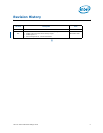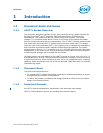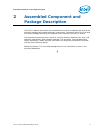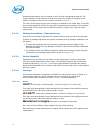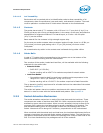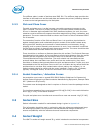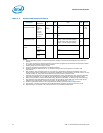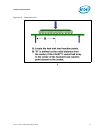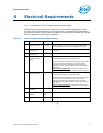
LGA 771 Socket Mechanical Design Guide 13
Mechanical Requirements
3.2.1.4.2 Lot Traceability
Each socket will be marked with a lot identification code to allow traceability of all
components, date of manufacture (year and week), and assembly location. The mark
must be placed on a surface that is visible when mounted on the motherboard.
3.2.1.5 Contacts
The socket has a total of 771 contacts, with 1.09 mm X 1.17 mm pitch (X by Y) in a
33x30 grid array with 15x14 grid depopulation in the center of the array and selective
depopulation for alignment features. For board layout, a 43 mils x 46 mils pitch
(X by Y) can be utilized.
Base material for the contacts is high strength copper alloy.
For the area on socket contacts where processor lands will mate, there is a 0.381 µm
[15 µinches] minimum gold plating over 1.27 µm [50 µinches] minimum nickel
underplate.
No contamination by solder in the contact area is allowed during solder reflow.
3.2.1.6 Solder Balls
A total of 771 solder balls corresponding to the contacts are on the bottom of the
socket for surface mounting with the motherboard.
Two versions of the socket, leaded and lead-free, will be available with the following
materials for the solder balls:
• Eutectic Solder
— Sn63 Pb37 (± 0.5% Sn).
— Socket marking will be LGA771 for sockets comprised of eutectic solder.
• Lead-free Solder
— Composition must be lead free and have a melting point temperature in the
range of 217-220°C (for example: Sn Ag 3.0 Cu 0.5).
— Socket marking will be LF-LGA771 for sockets comprised of lead-free solder.
The co-planarity (profile) requirement for all solder balls on the underside of the socket
is defined in Appendix A.
The solder ball pattern has a true position requirement with respect to applicable
datum’s in order to mate with the motherboard land pattern. See Appendix A.
3.2.2 Socket Actuation Mechanism
The socket actuation mechanism is made of the load plate and the load lever. These
components are made of stainless steel SUS 301. Both components need to be fully
actuated to ensure electrical contact. When correctly actuated, the top surface of the
processor IHS is above the load plate allowing proper installation of a heatsink. The
post-actuated seating plane of the package is flush with the seating plane of the
socket. Movement will be along the Z direction, perpendicular to the motherboard.
When combined with the socket body and load lever, the load plate distributes the force
necessary to achieve the required socket contact resistance values. The load from the
load plate is distributed across two sides of the package onto a step on each side of the
IHS. It is then distributed by the package across all of the contacts.



